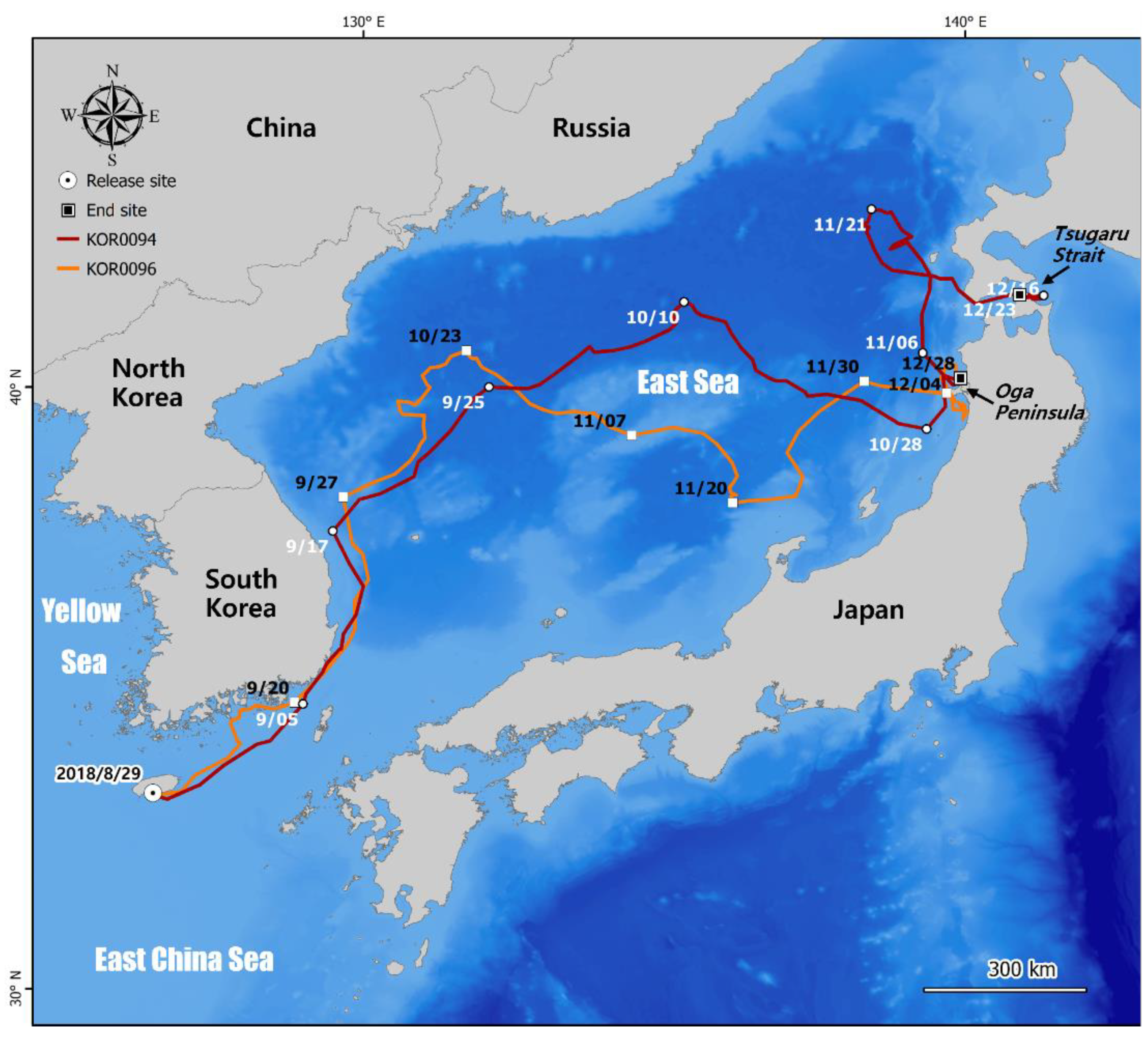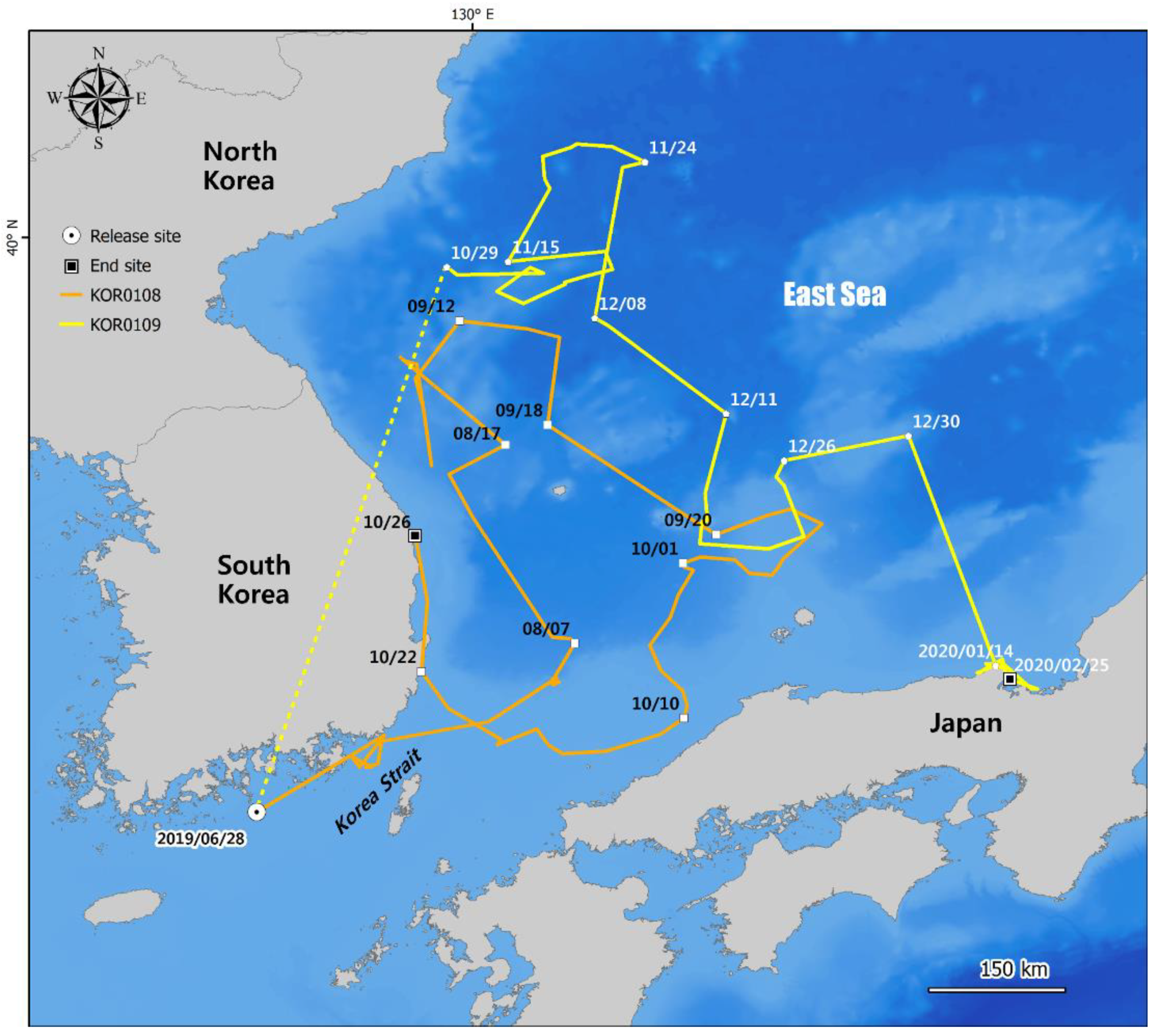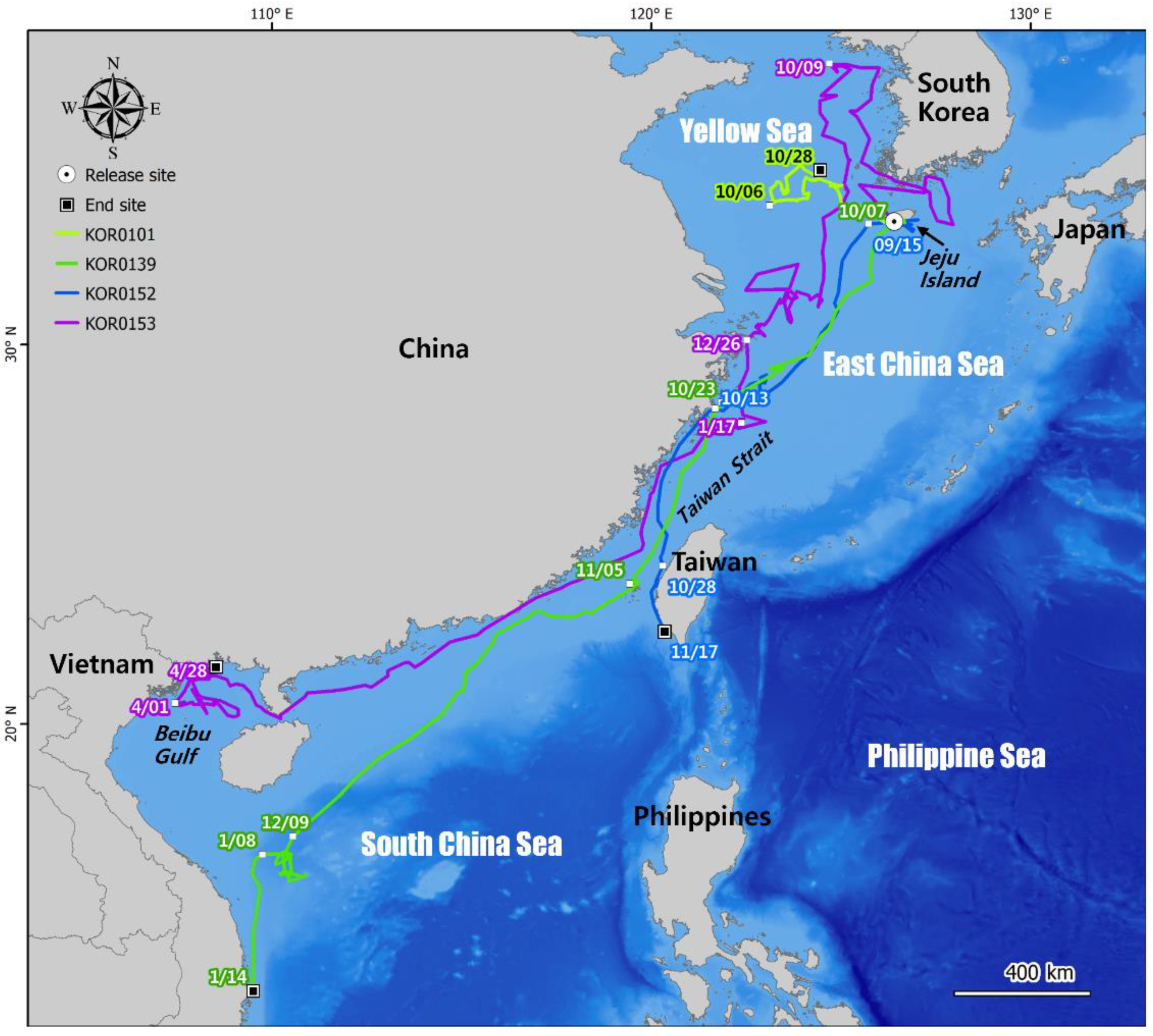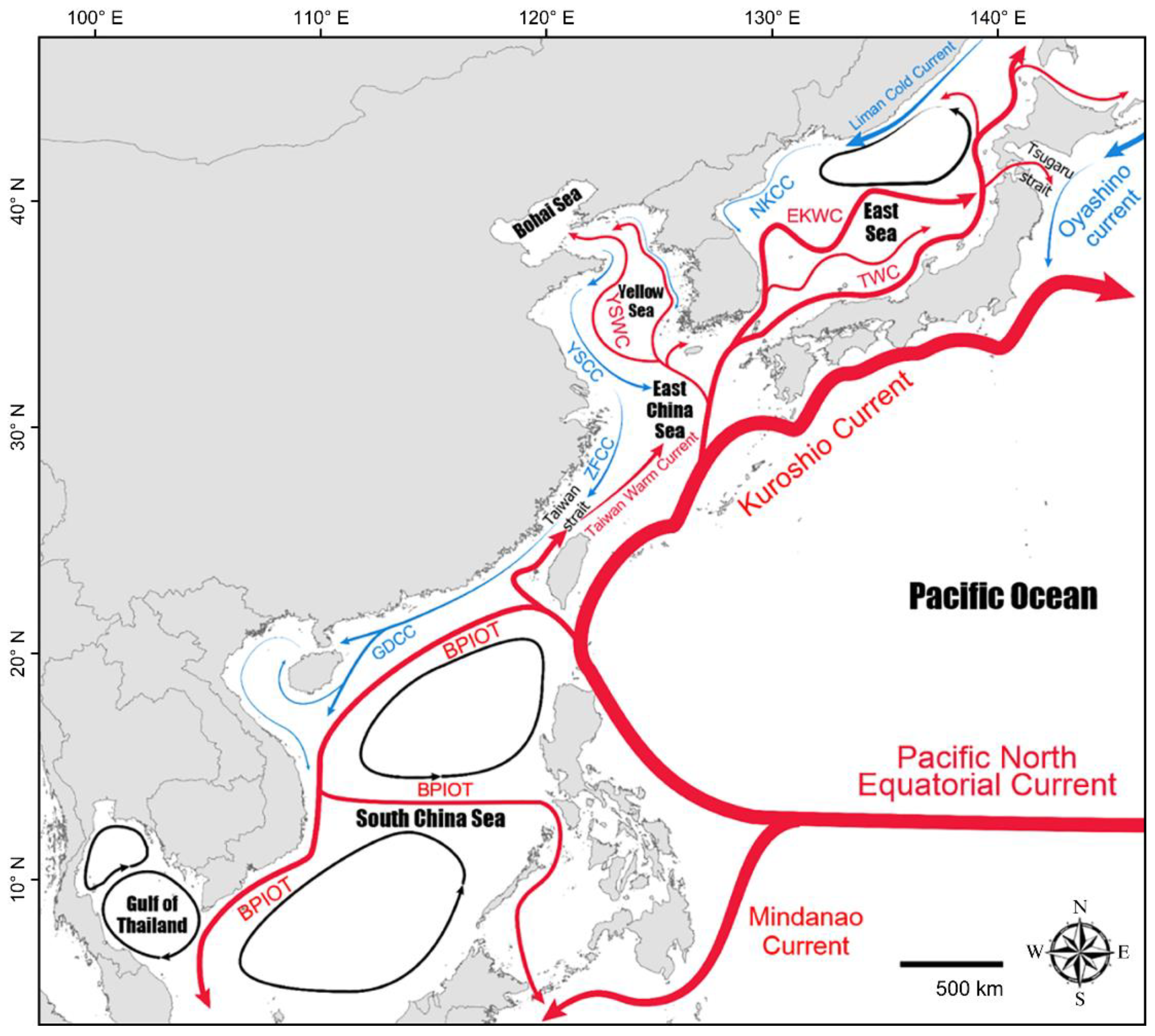Movement Patterns of Juvenile Loggerhead Turtles (Caretta caretta L. 1758) and Green Turtles (Chelonia mydas L. 1758) Hatched in Captivity and Released in the Korean Waters
Abstract
Simple Summary
Abstract
1. Introduction
2. Materials and Methods
2.1. Animals and Site
2.2. Satellite Tracking
3. Results
3.1. Satellite Tracking
3.2. Movement Patterns
4. Discussion
4.1. Movement Patterns of Loggerhead Turtles
4.2. Movement Patterns of Green Turtles
5. Conclusions
Author Contributions
Funding
Institutional Review Board Statement
Informed Consent Statement
Data Availability Statement
Acknowledgments
Conflicts of Interest
References
- Lutcavage, M.E.; Plotkin, P.; Witherington, B.; Lutz, P.L. Human Impacts on Sea Turtle Survival. In The Biology of Sea Turtles; Lutz, P.L., Musick, J.A., Eds.; CRC Press: Boca Raton, FL, USA, 1997; pp. 107–136. [Google Scholar]
- Fretey, J. Biogeography and Conservation of Marine Turtles of the Atlantic Coast of Africa; No 6. UNEP/CMS Secretariat; CMS Technical Series Publication: Bonn, Germany, 2001. [Google Scholar]
- Wallace, B.P.; Lewison, R.L.; McDonald, S.L.; McDonald, R.K.; Kot, C.Y.; Kelez, S.; Bjorkland, R.K.; Finkbeiner, E.M.; Helmbrecht, S.; Crowder, L.B. Global Patterns of Marine Turtle Bycatch. Conserv. Lett. 2010, 3, 131–142. [Google Scholar] [CrossRef]
- Lynch, J.M. Quantities of Marine Debris Ingested by Sea Turtles: Global Meta-analysis Highlights Need for Standardized Data Reporting Methods and Reveals Relative Risk. Environ. Sci. Technol. 2018, 52, 12026–12038. [Google Scholar] [CrossRef] [PubMed]
- Ng, C.K.Y.; Matsuzawa, Y. Sea Turtles in the East Asia Region: MTSG Annual Regional Report 2020. In Report of the IUCN-SSC Marine Turtle Specialist Group. 2020. Available online: https://www.iucn-mtsg.org/s/MTSG-Regional-Report_East-Asia_2020.pdf (accessed on 5 May 2022).
- IUCN. The IUCN Red List of Threatened Species. Version 2021-1. Available online: https://www.iucnredlist.org (accessed on 24 August 2021).
- Wold, C. The Status of Sea Turtles under International Environmental Law and International Environmental Agreements. J. Int. Wildl. Law Policy 2002, 5, 11–48. [Google Scholar] [CrossRef]
- Mazaris, A.D.; Schofield, G.; Gkazinou, C.; Almpanidou, V.; Hays, G.C. Global Sea Turtle Conservation Successes. Sci. Adv. 2017, 3, e1600730. [Google Scholar] [CrossRef] [PubMed]
- García, A.; Ceballos, G.; Adaya, R. Intensive Beach Management as an Improved Sea Turtle Conservation Strategy in Mexico. Biol. Conserv. 2003, 111, 253–261. [Google Scholar] [CrossRef]
- Wyneken, J.; Burke, T.J.; Salmon, M.; Pedersen, D.K. Egg Failure in Natural and Relocated Sea Turtle Nests. J. Herpetol. 1988, 22, 88–96. [Google Scholar] [CrossRef]
- Moon, D.Y.; Jung, M.M.; An, Y.R.; Choi, S.G.; Oh, B.S.; Kim, Z.G.; Lee, C.; Kim, M.J.; Kim, S.Y. Distribution and Strandings of Endangered Sea Turtles in Korean Waters. Korean J. Fish. Aquat. Sci. 2009, 42, 657–663. [Google Scholar] [CrossRef]
- Moon, D.Y.; An, Y.R.; Jung, M.M.; Kim, S.Y.; Choi, S.K.; Lee, H.Y.; Yoo, J.T.; Kim, M.J. Satellite Tracking of Green Sea Turtles Chelonia mydas in Korean Waters. Korean J. Fish. Aquat. Sci. 2011, 44, 709–716. [Google Scholar] [CrossRef]
- Jung, M.M.; Moon, D.Y.; Kim, S.H.; Kim, H.S.; Kim, J.W. Observation and Record of Sea Turtles in Bycatch and Stranding from Jeju Island of Korea. J. Fish. Mar. Sci. Edu. 2012, 24, 662–669. [Google Scholar] [CrossRef]
- Kim, I.H.; Yi, C.H.; Lee, J.H.; Park, D.; Cho, I.Y.; Han, D.J.; Kim, M.S. First Record of the Olive Ridley Sea Turtle Lepidochelys olivacea (Reptilia: Testudines: Cheloniidae) from South Korea. Curr. Herpetol. 2019, 38, 153–159. [Google Scholar] [CrossRef]
- Kim, I.H.; Yi, C.H.; Han, D.J.; Park, D.; Park, J.; Cho, I.Y.; Kim, M.S. First Record of the Hawksbill Turtle (Eretmochelys imbricata, Reptilia: Testudines: Cheloniidae) from South Korea. J. Asia-Pac. Biodivers. 2020, 13, 151–155. [Google Scholar] [CrossRef]
- Kim, I.H.; Moon, D.Y.; Cho, I.Y.; Kim, M.S.; An, Y.R.; Han, D.; Han, W.M.; Han, D.J.; Park, D. Occurrence of Sea Turtles in the Korean Waters and the Morphological Characteristics of Two Major Species. Korean J. Fish. Aquat. Sci. 2017, 50, 311–318. [Google Scholar] [CrossRef]
- Jung, M.M.; Moon, D.Y.; Kim, S.H.; Kim, H.S.; Kim, J.W. Environmental Conditions as Accidental Nesting Place of Seaturtle Located in Jeju Island of Korea. J. Fish. Mar. Sci. Edu. 2012, 24, 507–515. [Google Scholar] [CrossRef]
- García, R.A.; Cabeza, M.; Rahbek, C.; Araújo, M.B. Multiple Dimensions of Climate Change and Their Implications for Biodiversity. Science 2014, 344, 486. [Google Scholar] [CrossRef]
- Butt, N.; Whiting, S.; Dethmers, K. Identifying Future Sea Turtle Conservation Areas under Climate Change. Biol. Conserv. 2016, 204, 189–196. [Google Scholar] [CrossRef]
- MOF. Project Report: Facility Improvement and Restoration of Marine Ecosystem, Restoration of Marine Protected Species and Habitats. Ministry of Oceans and Fisheries: Sejong, Korea, 2020; pp. 489–519. [Google Scholar]
- Wood, J.R.; Wood, F.E. Artificial Incubation of Green Sea Turtle Eggs (Chelonia mydas). Proc. World Maric. Soc. 1979, 10, 215–221. [Google Scholar] [CrossRef]
- Arzola-González, J.F.; Barrón-Hernández, J.; Gutiérrez-Rubio, Y.; Voltolina, D.; Ramírez-Pérez, J.S. Artificial Nesting and Incubation of Olive Ridley Sea Turtle Lepidochelys olivácea (Testudines: Cheloniidae) Eggs. Ecosistemas Recur. Agropecu. 2019, 6, 595–599. [Google Scholar] [CrossRef]
- Witherington, B.E.; Bjorndal, K.A. Influences of Wavelength and Intensity on Hatchling Sea Turtle Phototaxis: Implications for Sea-finding Behavior. Copeia 1991, 4, 1060–1069. [Google Scholar] [CrossRef]
- Gyuris, E. The Relationship Between Body Size and Predation Rates on Hatchlings of the Green Turtle (Chelonia mydas): Is Bigger Better? In Sea Turtles of the Indo-Pacific: Research, Management and Conservation; Pilcher, N., Ismail, G., Eds.; Academic Press: New York, NY, USA, 2000; pp. 143–147. [Google Scholar]
- Godley, B.J.; Blumenthal, J.M.; Broderick, A.C.; Coyne, M.S.; Godfrey, M.H.; Hawkes, L.A.; Witt, M.J. Satellite Tracking of Sea Turtles: Where Have We Been and Where Do We Go Next? Endanger. Species Res. 2008, 4, 3–22. [Google Scholar] [CrossRef]
- Thums, M.; Whiting, S.D.; Reisser, J.W.; Pendoley, K.L.; Pattiaratchi, C.B.; Harcourt, R.G.; McMahon, C.R.; Meekan, M.G. Tracking Sea Turtle Hatchlings—A Pilot Study Using Acoustic Telemetry. J. Exp. Mar. Biol. Ecol. 2013, 440, 156–163. [Google Scholar] [CrossRef]
- Bowen, B.W. Tracking Marine Turtles with Genetic Markers. BioScience 1995, 45, 528–534. [Google Scholar] [CrossRef]
- Chambault, P.; de Thoisy, B.; Huguin, M.; Martin, J.; Bonola, M.; Etienne, D.; Gresser, J.; Hiélard, G.; Mailles, J.; Védie, F.; et al. Connecting Paths between Juvenile and Adult Habitats in the Atlantic Green Turtle Using Genetics and Satellite Tracking. Ecol. Evol. 2018, 8, 12790–12802. [Google Scholar] [CrossRef] [PubMed]
- Balazs, G.H.; Miya, R.K.; Beavers, S. Procedures to Attach a Satellite Transmitter to the Carapace of an Adult Green Turtle, Chelonia mydas. In Proceedings of the 15th Annual Symposium on Sea Turtle Biology and Conservation; NOAA Technical Memorandum: Hilton Head, SC, USA, 1996; pp. 21–26. [Google Scholar]
- Sakamoto, W.; Bando, T.; Arai, N.; Baba, N. Migration Paths of the Adult Female and Male Loggerhead Turtles Caretta caretta Determined through Satellite Telemetry. Fish. Sci. 1997, 63, 547–552. [Google Scholar] [CrossRef]
- Balazs, G.H.; Parker, D.M.; Rice, M.R. Ocean Pathways and Residential Foraging Locations for Satellite Tracked Green Turtles Breeding at French Frigate Shoals in the Hawaiian Islands. Micronesia 2017, 4, 1–19. [Google Scholar]
- Jang, S.; Balazs, G.H.; Parker, D.M.; Kim, B.Y.; Kim, M.Y.; Ng, C.K.Y.; Kim, T.W. Movements of Green Turtles (Chelonia mydas) Rescued from Pound Nets Near Jeju Island, Republic of Korea. Chelonian Conserv. Biol. 2018, 17, 236–244. [Google Scholar] [CrossRef]
- Snape, R.T.; Schofield, G.; White, M. Delineating Foraging Grounds of a Loggerhead Turtle Population through Satellite Tracking of Juveniles. Aquat. Conserv. Mar. Freshw. Ecosyst. 2020, 30, 1476–1482. [Google Scholar] [CrossRef]
- Luschi, P.; Hays, G.C.; Del Seppia, C.; Marsh, R.; Papi, F. The Navigational Feats of Green Sea Turtles Migrating from Ascension Island Investigated by Satellite Telemetry. Proc. R. Soc. Lond. B 1998, 265, 2279–2284. [Google Scholar] [CrossRef]
- Witt, M.J.; Åkesson, S.; Broderick, A.C.; Coyne, M.S.; Ellick, J.; Formia, A.; Hays, G.C.; Luschi, P.; Stroud, S.; Godley, B.J. Assessing Accuracy and Utility of Satellite-tracking Data Using Argos-linked Fastloc-GPS. Anim. Behav. 2010, 80, 571. [Google Scholar] [CrossRef]
- ESRI. ArcGIS Desktop Version 10.1. Redlands; Environmental Systems Research Institute: Redlands, CA, USA, 2011. [Google Scholar]
- Mansfield, K.L.; Wyneken, J.; Rittschof, D.; Walsh, M.; Lim, C.W.; Richards, P.M. Satellite Tag Attachment Methods for Tracking Neonate Sea Turtles. Mar. Ecol. Prog. Ser. 2012, 457, 181–192. [Google Scholar] [CrossRef][Green Version]
- Mansfield, K.L.; Wyneken, J.; Luo, J. First Atlantic Satellite Tracks of ‘Lost Years’ Green Turtles Support the Importance of the Sargasso Sea as a Sea Turtle Nursery. Proc. R. Soc. B 2021, 288, 20210057. [Google Scholar] [CrossRef]
- Stokes, L.; Wyneken, J.; Crowder, L.B.; Marsh, J. The Influence of Temporal and Spatial Origin on Size and Early Growth Rates in Captive Loggerhead Sea Turtles (Caretta caretta) in the United States. Herpetol. Conserv. Biol. 2006, 1, 71–80. [Google Scholar]
- Gyuris, E. The Rate of Predation by Fishes on Hatchlings of the Green Turtle (Chelonia mydas). Coral Reefs 1994, 13, 137–144. [Google Scholar] [CrossRef]
- Musick, J.A.; Limpus, C.J. Habitat Utilization and Migration in Juvenile Sea Turtles. In The Biology of Sea Turtles; Lutz, P.L., Musick, J.A., Eds.; CRC Press: Boca Raton, FL, USA, 1997; pp. 137–163. [Google Scholar]
- Saito, T.; Kurita, M.; Okamoto, H.; Kakizoe, Y.; Parker, D.; Briscoe, D.; Rice, M.; Polovina, J.; Balazs, G. Satellite Tracking Immature Loggerhead Turtles in Temperate and Subarctic Ocean Habitats around Sea of Japan. Micronesica 2018, 3, 1–20. [Google Scholar]
- Uchida, I.; Nishiwaki, M. Sea Turtles in the Waters Adjacent to Japan. In Biology and Conservation of Sea Turtles; Bjorndal, K., Ed.; Smithsonian Institution Press: Washington, DC, USA, 1982; pp. 317–319. [Google Scholar]
- Kamezaki, N.; Matsuzawa, Y.; Abe, O.; Asakawa, H.; Fujii, T.; Goto, K. Loggerhead Turtles Nesting in Japan. In Loggerhead Sea Turtles; Bolten, A.B., Witherington, B.E., Eds.; Smithsonian Institution Press: Washington, DC, USA, 2003; pp. 210–217. [Google Scholar]
- Casale, P.; Freggi, D.; Basso, R.; Argano, R. Size at Male Maturity, Sexing Methods and Adult Sex Ratio in Loggerhead Turtles (Caretta caretta) from Italian Waters Investigated through Tail Measurements. Herpetol. J. 2005, 15, 145–148. [Google Scholar]
- Nichols, W.J.; Resendiz, A.; Seminoff, J.A.; Resendiz, B. Transpacific Migration of a Loggerhead Turtle Monitored by Satellite Telemetry. Bull. Mar. Sci. 2000, 67, 937–947. [Google Scholar]
- Polovina, J.; Uchida, I.; Balazs, G.; Howell, E.A.; Parker, D.; Dutton, P. The Kuroshio Extension Bifurcation Region: A Pelagic Hotspot for Juvenile Loggerhead Sea Turtles. Deep-Sea Res. II Top. Stud. Oceanogr. 2006, 53, 326–339. [Google Scholar] [CrossRef]
- Okuyama, J.; Kitagawa, T.; Zenimoto, K.; Kimura, S.; Arai, N.; Sasai, Y.; Sasaki, H. Trans-Pacific Dispersal of Loggerhead Turtle Hatchlings Inferred from Numerical Simulation Modeling. Mar. Biol. 2011, 158, 2055–2063. [Google Scholar] [CrossRef]
- Abecassis, M.; Senina, I.; Lehodey, P.; Gaspar, P.; Parker, D.; Balazs, G.; Polovina, J. A Model of Loggerhead Sea Turtle (Caretta caretta) Habitat and Movement in the Oceanic North Pacific. PLoS ONE 2013, 8, e73274. [Google Scholar] [CrossRef]
- Uchida, S.; Teruya, H. Transpacific Migration of a Tagged Loggerhead Caretta caretta. In International Symposium on Sea Turtles; Okinawa Expo-Aquarium: Hiwasa, Japan, 1988. [Google Scholar]
- Resendiz, A.; Resendiz, B.; Nichols, W.J.; Seminoff, J.A.; Kamezaki, N. First Confirmed East-West Transpacific Movement of a Loggerhead Sea Turtle, Caretta caretta, Released in Baja California, Mexico. Pac. Sci. 1998, 52, 151–153. [Google Scholar]
- Polovina, J.J.; Kobayashi, D.R.; Parker, D.M.; Seki, M.P.; Balazs, G.H. Turtles on the Edge: Movement of Loggerhead Turtles (Caretta caretta) along Oceanic Fronts, Spanning Longline Fishing Grounds in the Central North Pacific, 1997–1998. Fish. Oceanogr. 2000, 9, 71–82. [Google Scholar] [CrossRef]
- Bjorndal, K.A.; Bolten, A.B.; Martins, H.R. Somatic Growth Model of Juvenile Loggerhead Sea Turtles Caretta caretta: Duration of Pelagic Stage. Mar. Ecol. Prog. Ser. 2000, 202, 265–272. [Google Scholar] [CrossRef]
- Limpus, C.J.; Limpus, D.J. The Loggerhead Turtle, Caretta caretta. in the Equatorial and Southern Pacific Ocean: A species in decline. In Biology and Conservation of Loggerhead Sea Turtles; Bolten, A.B., Witherington, B.E., Eds.; Smithsonian Institution Press: Washington, DC, USA, 2003; pp. 199–209. [Google Scholar]
- Ishihara, T.; Kamezaki, N.; Matsuzawa, Y.; Iwamoto, F.; Oshika, T.; Miyagata, Y.; Ebisui, C.; Yamashita, S. Reentery of Juvenile and Sub-Adult Loggerhead Turtles into Natal Waters of Japan. Curr. Herpetol. 2011, 30, 63–68. [Google Scholar] [CrossRef]
- Marquez, R. Sea Turtles of the World. In An Annotated and Illustrated Catalogue of Sea Turtle Species Known to Date; FAO Species Catalogue; FAO Fisheries Synopsis: Rome, Italy, 1990; p. 81. [Google Scholar]
- Casale, P.; Matsuzawa, Y. Caretta caretta (North Pacific Subpopulation). The IUCN Red List of Threatened Species 2015: E.T83652278A83652322. Available online: https://www.iucnredlist.org/species/83652278/83652322 (accessed on 1 August 2021).
- Dellinger, T.; Freitas, C. Movements and Diving Behaviour of Pelagic Stage Loggerhead Sea Turtles in the North Atlantic: Preliminary Results Obtained through Satellite Telemetry. In 19th Annual Symposium on Sea Turtle Biology and Conservation; Kalb, H.J., Wibbels, T., Eds.; NOAA Technical Memorandum: WA, DC, USA, 1999; pp. 155–157. [Google Scholar]
- Carr, A. New Perspectives on the Pelagic Stage of Sea Turtle Development. Conserv. Biol. 1989, 1, 103–121. [Google Scholar] [CrossRef]
- Bowen, B.W.; Bass, A.L.; Chow, S.M.; Bostrom, M.; Bjorndal, K.A.; Bolten, A.B.; Okuyama, T.; Bolker, B.M.; Epperly, S.; Lacasella, E.; et al. Natal Homing in Juvenile Loggerhead Turtles (Caretta caretta). Mol. Ecol. 2004, 13, 3797–3808. [Google Scholar] [CrossRef] [PubMed]
- Zhao, Y.; Wei, Z.; Wang, Y.; Xu, T.; Feng, Y. Correlation Analysis of the North Equatorial Current Bifurcation and the Indonesian Throughflow. Acta Oceanol. Sin. 2015, 34, 1–11. [Google Scholar] [CrossRef]
- Hu, J.; Wang, X.H. Progress on Upwelling Studies in the China Seas. Rev. Geophys. 2016, 54, 653–673. [Google Scholar] [CrossRef]
- KHOA. Physical Setting and Climate Change Patterns. Korea Hydrographic and Oceanographic Agency, Busan, Republic of Korea. 2016. Available online: http://nationalatlas.ngii.go.kr/pages/page_1270.php (accessed on 5 May 2022).
- Hirth, H.F. Synopsis of the Biological Data on the Green Turtle Chelonia mydas (Linnaeus 1758); Department of Biology University of Utah: Salt Lake City, UT, USA, 1997. [Google Scholar]
- Nishizawa, H.; Naito, Y.; Suganuma, H.; Abe, O.; Okuyama, J.; Hirate, K.; Tanaka, S.; Inoguchi, E.; Narushima, K.; Kobayashi, K.; et al. Composition of Green Turtle Feeding Aggregations along the Japanese Archipelago: Implications for Changes in Composition with Current Flow. Mar. Biol. 2013, 160, 2671–2685. [Google Scholar] [CrossRef]
- Fukuoka, T.; Narazaki, T.; Sato, K. Summer-Restricted Migration of Green Turtles Chelonia mydas to a Temperate Habitat of the Northwest Pacific Ocean. Endanger. Species Res. 2015, 28, 1–10. [Google Scholar] [CrossRef][Green Version]
- Fukuoka, T.; Narazaki, T.; Kinoshita, C.; Sato, K. Diverse Foraging Habits of Juvenile Green Turtles (Chelonia mydas) in a Summer-Restricted Foraging Habitat in the Northwest Pacific Ocean. Mar. Biol. 2019, 166, 25. [Google Scholar] [CrossRef]
- Mansfield, K.L.; Mendilaharsu, M.L.; Putman, N.F.; dei Marcovaldi, M.A.; Sacco, A.E.; Lopez, G.; Pires, T.; Swimmer, Y. First Satellite Tracks of South Atlantic Sea Turtle ‘Lost Years’: Seasonal Variation in Trans-Equatorial Movement. Proc. R. Soc. B 2017, 284, 20171730. [Google Scholar] [CrossRef]
- Balazs, G.H. Green Turtle Migrations in the Hawaiian Archipelago. Biol. Conserv. 1976, 9, 125–140. [Google Scholar] [CrossRef]
- Shamblin, B.M.; Bjorndal, K.A.; Bolten, A.B.; Nairn, C.J. Natal Homing by an Adult Male Green Turtle at Tortuguero, Costa Rica. MTN 2012, 134, 21. [Google Scholar]
- Limpus, C.J.; Limpus, D.J.; Arthur, K.E.; Parmenter, C.J. Monitoring Green Turtle Population Dynamics in Shoalwater by 2000–2004; Great Barrier Reef Marine Park Authority: Townsville, Australia, 2005; pp. 3–46.
- Arthur, K.E.; Boyle, M.C.; Limpus, C.J. Ontogenetic Changes in Diet and Habitat Use in Green Sea Turtle (Chelonia mydas) Life History. Mar. Ecol. Prog. Ser. 2008, 362, 303–311. [Google Scholar] [CrossRef]
- Van de Merwe, J.P.; Hodge, M.; Olszowy, H.A.; Whittier, J.M.; Ibrahim, K.; Lee, S.Y. Chemical Contamination of Green Turtle (Chelonia mydas) Eggs in Peninsular Malaysia: Implications for Conservation and Public Health. Environ. Health Perspect. 2009, 117, 1397–1401. [Google Scholar] [CrossRef] [PubMed]
- Jan, S.; Wang, J.; Chern, C.S.; Chao, S.Y. Seasonal Variation of the Circulation in the Taiwan Strait. J. Mar. Syst. 2002, 35, 249–268. [Google Scholar] [CrossRef]
- Anderson, S.J. HF Radar Network Design for Remote Sensing of the South China Sea. In Advanced Geoscience Remote Sensing; Marghany, M., Ed.; IntechOpen: Rijeka, Croatia, 2014; pp. 73–102. [Google Scholar] [CrossRef]
- Kämpf, J.; Chapman, P. Seasonal Wind-Driven Coastal Upwelling Systems. In Upwelling Systems of the World; Springer: Cham, Switzerland, 2016; pp. 315–361. [Google Scholar] [CrossRef]




| Species | Turtle ID | Hatching Date | Release Date | Age (Months) | CCL (cm) | CCW (cm) | Body Weight (kg) | Tracking Days | Used in Analysis |
|---|---|---|---|---|---|---|---|---|---|
| Caretta caretta | KOR0093 | Aug 2015 | 29 Aug 2018 | 36 | 42.0 | 36.0 | 14.8 | 10 | X |
| KOR0094 | Aug 2015 | 29 Aug 2018 | 36 | 44.0 | 37.0 | 14.6 | 115 | O | |
| KOR0095 | Aug 2015 | 29 Aug 2018 | 36 | 43.0 | 36.0 | 14.4 | 8 | X | |
| KOR0096 | Aug 2015 | 29 Aug 2018 | 36 | 38.5 | 34.0 | 12.7 | 122 | O | |
| KOR0108 | Aug 2015 | 28 Jun 2019 | 46 | 55.6 | 45.7 | 26.5 | 121 | O | |
| KOR0109 | Aug 2015 | 28 Jun 2019 | 46 | 52.1 | 44.1 | 23.8 | 244 | O | |
| Chelonia mydas | KOR0098 | Apr 2017 | 29 Aug 2018 | 16 | 24.8 | 23.0 | 2.48 | 13 | X |
| KOR0099 | Apr 2017 | 29 Aug 2018 | 16 | 24.5 | 21.1 | 2.21 | 6 | X | |
| KOR0100 | Apr 2017 | 29 Aug 2018 | 16 | 25.6 | 22.5 | 2.62 | - | X | |
| KOR0101 | Apr 2017 | 29 Aug 2018 | 16 | 27.1 | 23.4 | 2.67 | 61 | O | |
| KOR0123 | Apr 2017 | 28 Aug 2019 | 28 | 37.4 | 30.9 | 6.2 | - | X | |
| KOR0124 | Apr 2017 | 28 Aug 2019 | 28 | 35.2 | 30.3 | 5.7 | - | X | |
| KOR0137 | Jun 2017 | 11 Sep 2020 | 41 | 36.9 | 31.0 | 6.3 | 28 | X | |
| KOR0138 | Jun 2017 | 11 Sep 2020 | 41 | 43.0 | 39.3 | 9.1 | - | X | |
| KOR0139 | Jun 2017 | 11 Sep 2020 | 41 | 45.1 | 35.0 | 10.2 | 125 | O | |
| KOR0152 | Apr 2017 | 26 Aug 2021 | 52 | 58.4 | 51.9 | 22.1 | 83 | O | |
| KOR0153 | Apr 2017 | 26 Aug 2021 | 52 | 55.8 | 48.8 | 18.5 | 226 | O |
| Species | Turtle ID | Release Location | Final Location | Tracking | Traveled Distance (km) | |||
|---|---|---|---|---|---|---|---|---|
| Period | Days | Numbers | Total | Mean Daily | ||||
| Caretta caretta | KOR0094 | Jeju | 41.54370° N 140.91959° E | 29 Aug. 2018–23 Dec. 2018 | 115 | 113 | 2885 | 30.6 ± 24.1 |
| KOR0096 | Jeju | 40.15199° N 139.91525° E | 29 Aug. 2018–28 Dec. 2018 | 122 | 121 | 2519 | 24.9 ± 20.4 | |
| KOR0108 | Yeosu | 37.04580° N 129.43513° E | 28 Jun. 2019–26 Oct. 2019 | 121 | 62 | 2510 | 35.3 ± 34.9 | |
| KOR0109 | Yeosu | 35.61106° N 135.20114° E | 28 Jun. 2019–28 Feb. 2020 | 244 | 61 | 2455 | 18.7 ± 22.3 | |
| Chelonia mydas | KOR0101 | Jeju | 34.59641° N 124.42068° E | 29 Aug. 2018–28 Oct. 2018 | 61 | 60 | 909 | 18.1 ± 13.1 |
| KOR0139 | Jeju | 12.97541° N 109.50287° E | 11 Sep. 2020–14 Jan. 2021 | 125 | 110 | 3838 | 34.5 ± 35.2 | |
| KOR0152 | Jeju | 22.45610° N 120.35793° E | 26 Aug. 2021–17 Nov. 2022 | 83 | 68 | 6309 | 30.4 ± 30.0 | |
| KOR0153 | Jeju | 21.50072° N 108.45682° E | 26 Aug. 2021–28 Apr. 2022 | 226 | 187 | 2134 | 29.4 ± 23.2 | |
Publisher’s Note: MDPI stays neutral with regard to jurisdictional claims in published maps and institutional affiliations. |
© 2022 by the authors. Licensee MDPI, Basel, Switzerland. This article is an open access article distributed under the terms and conditions of the Creative Commons Attribution (CC BY) license (https://creativecommons.org/licenses/by/4.0/).
Share and Cite
Kim, I.-H.; Park, I.-K.; Han, D.-J.; Kim, M.-S.; Park, D.; Moon, D.-Y.; Cho, I.-Y.; Im, J.-E.; Park, J.; An, Y.-R. Movement Patterns of Juvenile Loggerhead Turtles (Caretta caretta L. 1758) and Green Turtles (Chelonia mydas L. 1758) Hatched in Captivity and Released in the Korean Waters. Animals 2022, 12, 2157. https://doi.org/10.3390/ani12162157
Kim I-H, Park I-K, Han D-J, Kim M-S, Park D, Moon D-Y, Cho I-Y, Im J-E, Park J, An Y-R. Movement Patterns of Juvenile Loggerhead Turtles (Caretta caretta L. 1758) and Green Turtles (Chelonia mydas L. 1758) Hatched in Captivity and Released in the Korean Waters. Animals. 2022; 12(16):2157. https://doi.org/10.3390/ani12162157
Chicago/Turabian StyleKim, Il-Hun, Il-Kook Park, Dong-Jin Han, Min-Seop Kim, Daesik Park, Dae-Yeon Moon, In-Young Cho, Ji-En Im, Jaejin Park, and Yong-Rock An. 2022. "Movement Patterns of Juvenile Loggerhead Turtles (Caretta caretta L. 1758) and Green Turtles (Chelonia mydas L. 1758) Hatched in Captivity and Released in the Korean Waters" Animals 12, no. 16: 2157. https://doi.org/10.3390/ani12162157
APA StyleKim, I.-H., Park, I.-K., Han, D.-J., Kim, M.-S., Park, D., Moon, D.-Y., Cho, I.-Y., Im, J.-E., Park, J., & An, Y.-R. (2022). Movement Patterns of Juvenile Loggerhead Turtles (Caretta caretta L. 1758) and Green Turtles (Chelonia mydas L. 1758) Hatched in Captivity and Released in the Korean Waters. Animals, 12(16), 2157. https://doi.org/10.3390/ani12162157






